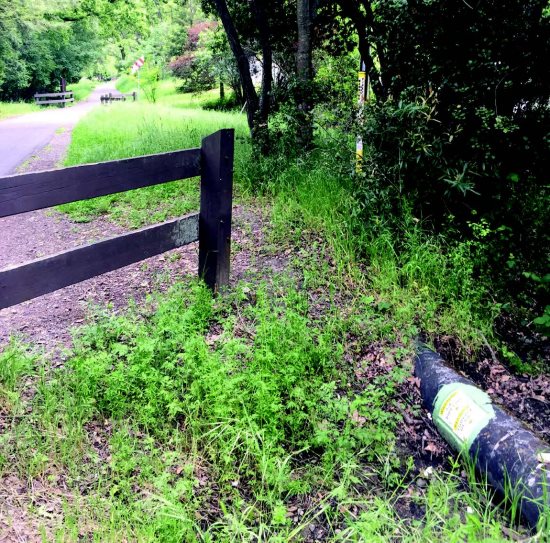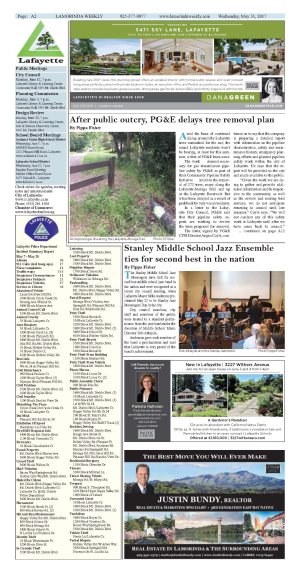| | Published May 31st, 2017
| After public outcry, PG&E delays tree removal plan
| | | By Pippa Fisher |  | | An exposed gas line along the Lafayette-Moraga Trail. Photo P. Fisher |
Amid the buzz of continued dialog around the Lafayette trees earmarked for the axe, the sound Lafayette residents won't be hearing, at least for this summer, is that of PG&E buzz-saws.
 The work - deemed necessary for gas transmission pipeline safety by PG&E as part of their Community Pipeline Safety Initiative - involves the removal of 272 trees, many along the Lafayette-Moraga Trail and up at the Lafayette Reservoir. But it has been delayed as a result of pushback by very vocal residents.
The work - deemed necessary for gas transmission pipeline safety by PG&E as part of their Community Pipeline Safety Initiative - involves the removal of 272 trees, many along the Lafayette-Moraga Trail and up at the Lafayette Reservoir. But it has been delayed as a result of pushback by very vocal residents.
 In a letter to the Lafayette City Council, PG&E said that their pipeline safety experts are working to review the trees proposed for removal.
In a letter to the Lafayette City Council, PG&E said that their pipeline safety experts are working to review the trees proposed for removal.
 The letter, signed by PG&E CPSI Director Angus Coyle, continues on to say that the company is preparing a detailed report with information on the pipeline characteristics, safety and maintenance history, emergency planning efforts and planned pipeline safety work within the city of Lafayette. He says that the report will be provided to the city and made available to the public.
The letter, signed by PG&E CPSI Director Angus Coyle, continues on to say that the company is preparing a detailed report with information on the pipeline characteristics, safety and maintenance history, emergency planning efforts and planned pipeline safety work within the city of Lafayette. He says that the report will be provided to the city and made available to the public.
 "Given the work we are doing to gather and provide additional information and be responsive to the community, as well as the review and nesting bird surveys, we do not anticipate returning to council until late summer," Coyle says. "We will not conduct any of this safety work in Lafayette until after we have come back to council."
"Given the work we are doing to gather and provide additional information and be responsive to the community, as well as the review and nesting bird surveys, we do not anticipate returning to council until late summer," Coyle says. "We will not conduct any of this safety work in Lafayette until after we have come back to council."
 Mayor Mike Anderson expects the council to receive a comprehensive report from PG&E at a regularly scheduled city council meeting later in the summer and that the report will respond fully to the alternatives and options raised by residents to avoid the removal of the trees.
Mayor Mike Anderson expects the council to receive a comprehensive report from PG&E at a regularly scheduled city council meeting later in the summer and that the report will respond fully to the alternatives and options raised by residents to avoid the removal of the trees.
 Anderson says, "I am hopeful that the safety and integrity of the pipeline can be maintained with removal of only the trees proved to be absolutely necessary to achieve this goal, with no other reasonable option available."
Anderson says, "I am hopeful that the safety and integrity of the pipeline can be maintained with removal of only the trees proved to be absolutely necessary to achieve this goal, with no other reasonable option available."
 However, Lafayette resident and founder of the Save Lafayette Trees organization Michael Dawson does not share that optimism. "We don't have firm confirmation that any trees will be spared, and the letter from Angus Coyle demonstrates they are simply delaying the same unfortunate effects of the same agreement." Dawson says that it does not change their organization's stance.
However, Lafayette resident and founder of the Save Lafayette Trees organization Michael Dawson does not share that optimism. "We don't have firm confirmation that any trees will be spared, and the letter from Angus Coyle demonstrates they are simply delaying the same unfortunate effects of the same agreement." Dawson says that it does not change their organization's stance.
 During a recent walk along the trail by PG&E representatives and concerned residents, Dawson says they brought up many questions, such as why they would take down trees where the slope is failing? What about the nesting birds?
During a recent walk along the trail by PG&E representatives and concerned residents, Dawson says they brought up many questions, such as why they would take down trees where the slope is failing? What about the nesting birds?
 "Will they pour pesticides on trees so close to Las Trampas Creek? How can PG&E be certain of trees ownership along the trail along property lines? Why is there an exposed section of pipe? Where are their safety valves? How does a pipe travel under the deep creek beds? How do they test and inspect the pipes?" he asks.
"Will they pour pesticides on trees so close to Las Trampas Creek? How can PG&E be certain of trees ownership along the trail along property lines? Why is there an exposed section of pipe? Where are their safety valves? How does a pipe travel under the deep creek beds? How do they test and inspect the pipes?" he asks.
 Dawson says that they would like PG&E to post notices on the trees slated for removal, conduct the appropriate environmental reviews, and respond back with confirmation that the trees of community concern are no longer under consideration.
Dawson says that they would like PG&E to post notices on the trees slated for removal, conduct the appropriate environmental reviews, and respond back with confirmation that the trees of community concern are no longer under consideration.
 Lafayette resident David Kosters says that he was encouraged by PG&E's decision to delay the start of their planned removal of Lafayette trees, and its intent to prepare a detailed report about the pipeline's history and planned safety improvements in Lafayette.
Lafayette resident David Kosters says that he was encouraged by PG&E's decision to delay the start of their planned removal of Lafayette trees, and its intent to prepare a detailed report about the pipeline's history and planned safety improvements in Lafayette.
 But Kosters says, "However, many serious technical issues have been raised by members of the community about this project. I continue to believe that the responsible way to reconcile those issues is to commission a small group representing all stakeholders (including Lafayette residents) who would roll up their sleeves, examine the technical issues and patiently reach a consensus recommendation."
But Kosters says, "However, many serious technical issues have been raised by members of the community about this project. I continue to believe that the responsible way to reconcile those issues is to commission a small group representing all stakeholders (including Lafayette residents) who would roll up their sleeves, examine the technical issues and patiently reach a consensus recommendation."
 But for the summer at least, the chainsaws are quiet while dialog continues.
But for the summer at least, the chainsaws are quiet while dialog continues.


|
| | | | | | | | | | | | |




